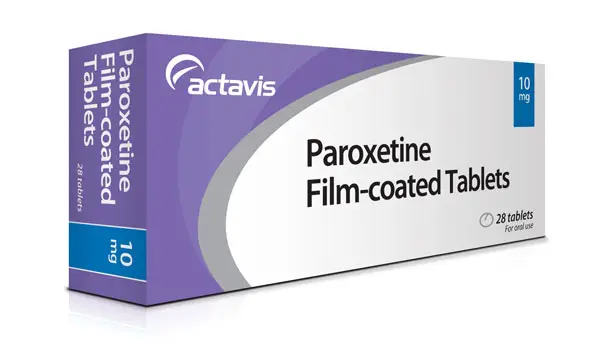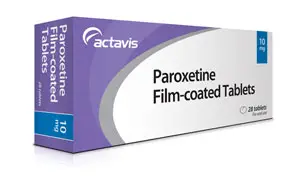As you likely know, depression is a common problem for those of us who deal with fibromyalgia. Because of that, it’s common that fibromyalgia sufferers will end up taking some sort of antidepressant or anti-anxiety medication as part of a treatment plan.
Sometimes, those same medications end up giving us a lot of relief when it comes to our pain as well. Paroxetine, which is known as the brand name medication Paxil, is actually quite effective in this sense, which is why we need to look at and understand it.
What is Paroxetine and How is it Used For Depression Treatment?
As mentioned above, Paroxetine is known by its brand name, Paxil, and is used to help patients who are struggling with anxiety, depression and other mental health disorders. Basically, what it does is it helps the mind to get resituated when there is a problem going on that causes it to feel the issues.
The brain has a number of chemicals in it that communicate with one another, and when those chemicals are out of whack or they aren’t balanced (either too much or too little), you are more apt to deal with issues with your mental health.
These chemicals, which are called neurotransmitters, are incredibly important for keeping healthy mentally and it can do a huge number if they aren’t working correctly.
So, when you start taking Paroxetine, you will start to notice that there are differences in the way that you feel. The brain, over time, starts to resituate itself and makes it so that you are able to function better overall.
You have an easier time thinking clearly and the depressive moods become less severe. By resituating the brain, you are now able to cope with your depression or anxiety more readily, thus increasing your quality of life.
The Paroxetine essentially “kick starts” your happy hormones (specifically, serotonin) so that you get more of them.
It is important to note that it takes some time for these changes to occur. As with many of the antidepressants and anti-anxiety medications that are in that same category as Paroxetine, it takes a few weeks before you really start to see changes in your mental health and wellness.
After about four weeks, your doctor will be able to determine if any changes need to be made with your medication.
On top of that, Paroxetine has a few other uses as well. In some people who have obsessive-compulsive disorders (OCD, etc), it has been discovered that the use of Paroxetine has made the behaviors less common and has helped the patient(s) to become less anxious when their compulsions are not acted upon.
It can also be used to treat other anxiety disorders and has been known to help patients who have severe mood swings due to hormonal changes in the body over time.
One reason that Paroxetine is popular is that it doesn’t have very uncomfortable side effects associated with it. If you have any side effects, they are usually related to the digestive system, in the form of constipation and diarrhea.
In rare cases, dry mouth, sexual issues, and appetite problems may also occur. But, for most patients, these side effects will subside once the body gets adjusted to the drug, and unless there is something that seems to be making your symptoms worse, it’s not anything that you need to be concerned about.
When you start Paroxetine, make sure you keep track of your symptoms and take note of any changes occur.

How Can Paroxetine Be Used For Fibromyalgia Relief?
All that being said, what role can Paroxetine actually play when we’re getting our treatment for fibromyalgia? How can it help us to deal with our symptoms better, and can it grant us relief from other symptoms that we are coping with?
At this point, there is currently no conclusive evidence that shows that Paroxetine does anything for the pain that we deal with as a fibromyalgia patient.
There are still tests going on, however, and it is believed that it may help to increase the effectiveness of other medications that are used to control the pain that many fibromyalgia sufferers deal with on a regular basis.
But that doesn’t mean that Paroxetine is totally useless for fibromyalgia sufferers. Actually, it’s quite the opposite. People suffering from fibromyalgia often have mental health issues as a result of the constant pain they are dealing with.
Whether they are anxious because they aren’t sure where the pain is coming from or whether or not it will get more severe, or they are depressed because they cannot get out of the situation that they are in, it’s a common predicament to be in.
So, because of that, Paroxetine has been tested on a number of fibromyalgia patients that have been suffering from these specific mental health disorders alongside their pain.
Many of the tests that have been done have shown that, in fact, Paroxetine can play a huge role in helping to lift a person’s mood and allowing them to find relief from their anxiety and depression symptoms.
That, in turn, does actually have a positive effect on pain – if you aren’t as stressed out or anxious, your pain symptoms are going to be less severe overall.
Paroxetine is, because of these studies, often put into treatment plans as a part of what’s going on. That way, the patient can get the most relief from the most symptoms, instead of ignoring certain ones.
Paroxetine is just one of many products that have multiple uses for those that are suffering from fibromyalgia, and the fewer medications you are on, the better it will be for you and for your overall health.
Your doctor can give you more information about how Paroxetine can work for your particular case and whether or not it is a good choice. Always talk to your doctor or another specialist before making any change in your treatment plan.
References:
http://www.medicinenet.com/script/main/art.asp?articlekey=19972
http://www.fibromyalgia-symptoms.org/paroxetine.html

Do your research before taking ANY medication for Fibromyalgia. Better yet, have your vitamin D levels checked and I’ll bet they are severely low. Supplement with high doses, c.10,000 IU a day until your levels reach an optimum level of around 75 – 80 nmol/litre.